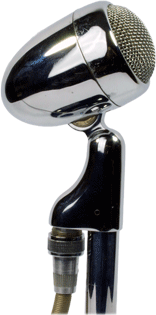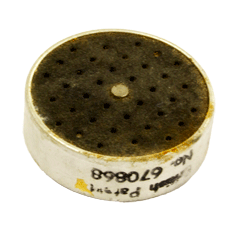|
|
The B 110 'Reporter' crystal microphone, from shortly after the 2nd World War, made by the Amsterdam firm Ronette. The company name refers to the pharmacist Piere Seignette, from La Rochelle, France, who first experimented with the piezoelectric properties of Rochelle salt crystals. If these salt crystals are deformed under pressure, they deliver an electric voltage. The first microphones that made use of this principle were manufactured by the American Brush Development Company, in the thirties. Ronette used Brush patents for the cartridge of their microphones: the filter cell. The B 110 'Reporter' was one of their first models and dates from 1946. The material from which the housing is made was called Polopas; a bakelite like plastic. The microphone was available in the colors dark brown and the more expensive ivory.
The choice of a plastic housing is probably because of the lack of metal, shortly after the war. The microphones were relatively inexpensive, which made them extremely popular, for instance to be used with a tape recorder.*)
Except for this purpose the Ronettes were also intended for P.A. use, paging systems and for citizen band radio and other amateur uses. All models were guaranteed for use in the tropics (which is certainly not true for all brands of crystal mikes)
There were also more expensive types that were made entirely of metal: the GS 210 and GS 310, both with a swivle stand mount, on which the microphone could be tilted into a vertical position, for omni directional use. These types contain the same elements, but were designed for more rugged use. Among others, they were used by many Indo-Rockers, like the Blue Diamonds. Because the metal versions often yielded a shock of (static) electricity, they were often used with a nylon stocking (or a handkerchief) covering them. The plastic B 110s were also frequently stuffed inside, with a handkerchief, to dampen the housing, this could help to prevent feedback.
Today many Ronettes are still used by harmonica players.
According to Ronette, the B 110 'Reporter' was the most used microphone in Europe, for PA, tape- and wire-recorders and amateurs. Ronette also produced pick-up arms, cartridges and needles. The company had offices in the Netherlands, the U.S. and Australia. In Germany Ronette first sold microphones under its own name, later badged as Schumann and Merula.
In the early 1970s all production ended and the business was closed.
*) The tape recorder was developed during the 2nd World War by the Germans. After the war, the Americans brought along some devices as spoils of war, and the American industry began production; first for the professional market, but soon also for amateur use.
|
|
Ronette FC 5 Filtercel

Ronette GS 210
|



